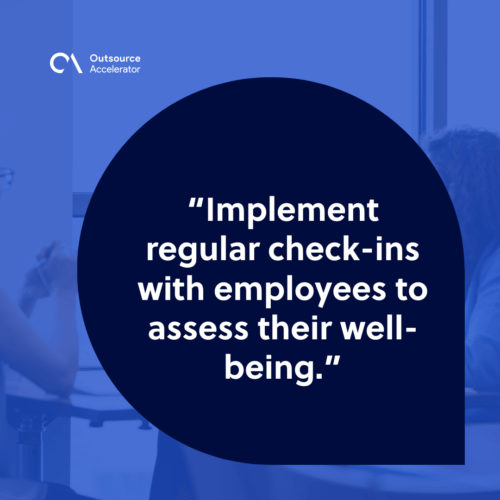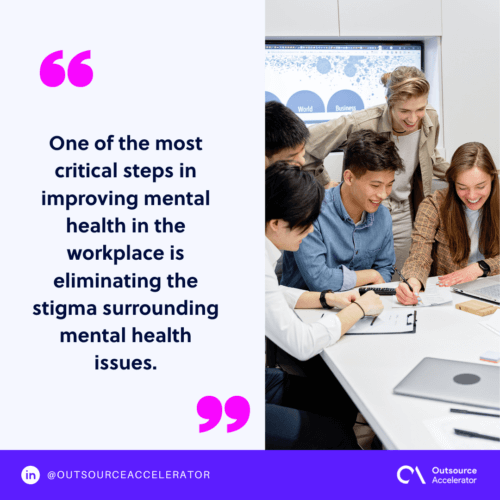7 ways to improve mental health in the workplace

A demanding workplace that fails to prioritize employees’ mental health can experience severe negative consequences. This affects both the individuals within the organization and the company.
Employee well-being may deteriorate, increasing stress levels, burnout, and mental health issues.
According to the American Psychological Association, 26% of workers reported negative effects of work-related stress, such as losing interest, motivation, or energy. This includes depression and anxiety.
The overall work atmosphere may become toxic and strained when not addressed immediately.
As an employer, it is your responsibility to create an environment where employees can professionally and mentally thrive.
Read on to discover how to improve mental health in the workplace. Learn about the seven successful approaches for enhancing workplace mental health.
7 ways to improve mental health in the workplace
Unlocking the potential for a healthier and more productive workplace involves implementing various strategies and practices.
Here are seven ways you can improve mental health in your company:
1. Recognize signs of stress in employees
One of the first steps in improving mental health in the workplace is to recognize the signs of stress in your employees.
Stress can manifest in various ways, such as:
- Increased absenteeism
- Decreased productivity
- Irritability
- Physical symptoms (e.g., headaches or digestive issues)
By being vigilant and observant, employers can identify these signs and take proactive steps to support their team members.
How to improve mental health in the workplace
Implement regular check-ins with employees to assess their well-being. Encourage them to discuss their stressors and offer assistance when needed openly.
Moreover, training managers to recognize these signs and respond appropriately is vital in creating a supportive work environment.

2. Promote a positive work environment
A positive work environment is essential for enhancing mental health in the workplace. When employees feel valued, appreciated, and included, they are likelier to experience lower stress levels and higher job satisfaction.
Creating a positive atmosphere starts with fostering a culture of respect, empathy, and teamwork.
How to improve mental health in the workplace
Promote diversity and inclusion within your organization, ensure everyone feels heard and respected.
Encourage collaboration and celebrate achievements as a team. Recognize and reward employees for their hard work and contributions. Doing so can boost their self-esteem and motivation.
3. Encourage open communication
Effective communication is a cornerstone of good mental health in the workplace. Employees should feel comfortable sharing their thoughts, concerns, and ideas without fear of judgment or retaliation.
An open and transparent communication channel allows for early detection of potential issues and enables timely intervention.
How to improve mental health in the workplace
Create a safe space for employees to voice their opinions and concerns.
Hold regular team meetings and one-on-one check-ins to discuss work-related matters and personal well-being. Encourage managers to listen and provide constructive feedback actively.
4. Offer better compensation
Financial stress significantly contributes to poor mental health.
When employees struggle to make ends meet, their stress levels can skyrocket. This can greatly affect their performance and overall well-being.
Offering fair and competitive compensation packages can alleviate this burden.
How to improve mental health in the workplace
Conduct regular salary reviews to ensure your employees’ compensation aligns with industry standards.
According to SHRM’s survey, 68% of employees disclosed that their overall benefits were a major factor in their job happiness. Consider additional benefits such as performance bonuses, stock options, or flexible spending accounts to enhance their financial security and job satisfaction.
5. Set up a happy hour more often
Social connections are essential for mental health.
Hosting regular happy hours or team-building activities can improve workplace relationships and create a more relaxed atmosphere.
How to improve mental health in the workplace
Schedule regular social gatherings, both in-person and virtually, to accommodate remote workers.
Ensure that these events are inclusive and accessible to all employees, regardless of their location or preferences. These events allow employees to unwind, bond with colleagues, and reduce stress.
6. End the stigma around mental health
One of the most critical steps in improving mental health in the workplace is eliminating the stigma surrounding mental health issues. Many employees may hesitate to seek help due to fear of judgment and invalidation.
It’s essential to foster an environment where seeking support for mental health concerns is encouraged and normalized.

How to improve mental health in the workplace
Launch awareness campaigns to educate employees about mental health. Provide resources like Employee Assistance Programs (EAPs) and access to mental health professionals.
Further, training managers and supervisors to respond empathetically and supportively when employees seek help can also make a huge difference.
7. Encourage employee self-care practices
Self-care is vital to maintaining good workplace mental well-being. Encourage employees to prioritize self-care by offering resources and opportunities to recharge and de-stress.
This can include flexible work hours, wellness programs, or mindfulness and stress-management workshops.
How to improve mental health in the workplace
Create a wellness program that promotes physical and mental well-being.
Your organization can offer workshops on stress reduction, time management, and mindfulness. This provides employees with the right resources for maintaining a healthy work-life balance.
Benefits of improving mental health in the workplace
Let’s delve into the significant advantages of these workplace mental health strategies for your organization.
Enhanced productivity
A mentally healthy workforce can tackle challenges with resilience, creativity, and a positive attitude. When employees’ mental health is prioritized, they are more likely to be engaged, motivated, and focused on their tasks.
Higher employee engagement and satisfaction
Improving mental health fosters a culture where employees feel valued and supported.
When employees feel treated as part of the company’s vision rather than just a revenue generator, they are likelier to stay with your organization.
This ultimately reduces turnover rates and other associated costs from employee churn.
Decreased healthcare costs
Investing in mental health initiatives can significantly save healthcare expenses.
Employees with good mental health are less likely to require medical treatment for workplace stress. This reduces the burden on your company’s healthcare budget.
Increased employee retention rates
A workplace prioritizing mental health becomes an attractive destination for top talent. When employees feel their well-being is valued, they are more likely to remain loyal to the organization.
Higher employee retention rates mean reduced recruitment and training costs. A mentally healthy workforce may also refer talents to your company, reducing the time and effort the recruitment team spends.

Improve workplace mental health one step at a time
Improving mental health in the workplace is an ongoing process requiring commitment and dedication from employers and employees.
How to improve mental health in the workplace? Begin this initiative by assessing your current workplace culture and identifying areas for improvement.
Then, implement these strategies gradually, involving employees in the process and seeking feedback.
The journey to a mentally healthy workplace begins with a single step, and each step you take brings you closer to achieving this essential goal!







 Independent
Independent




